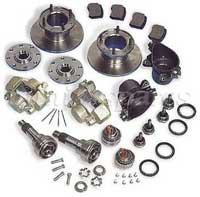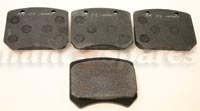
New Brake Discs
Thoroughly clean the new discs with a solvent degreaser such as brake cleaner or cellulose thinners to prevent pad contamination, then follow the following procedure to bed the new brakes in.
1. Perform several light stops (‘snubs’) on the first lap using progressively higher pedal pressure and braking force from higher speeds. Read more
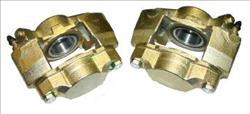
We have just released our brand new 8.4" calipers, that were original fitment to later 1275 Gt's and all Mini's after 1980
Having not been available new for several years, Minispares have stepped in and had these remanufactured from new castings...
Order as part number 37H8128 for R/H
Order as part number 37H8129 for L/H Read more

This kit allows the Minispares Alloy 4 Pot Calipers ( C-AJJ4022 / C-AJJ4023 ) to be used with the vented discs from the Metro.
Contained in the C-AJJ4021 spacer kit are the following: 4 Spacers, 8 ‘O’ Rings, 8 Bolts, Pad Pins and Retaining Plates.
When using the vented brake kit with 10” wheels the Metro brake disc will need machining down from 8.4” to 7.5” and the fitment of Minispares drive flange ( NAM6450F ) Read more
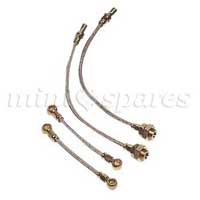
This pipe kit is for converting Metro 4 pot callipers with dual feed pipes to a single feed as used on minis.
It is necessary however, to check that this is permitted by the legislation in the country in which the vehicle is to used. To ensure maximum...
Read more
These calipers are intended for use on 10”wheels with 7.5”diameter solid brake discs.
The kit contains:-
2 calipers, one right and one left hand. Please ensure that they are installed correctly with the bleed screws in the vertical position (i.e. at the top)
4 longer hub fixing bolts(53K1049)
4 bolt washers(21017Z
4 round spacers (AN1380) which go between hub and caliper where the fixing bolts locate. Bolts and spacers not required when fitting to vented discs
1 set of brake pad split pins (GBK1025) BUT NO BRAKE PADS. Read more
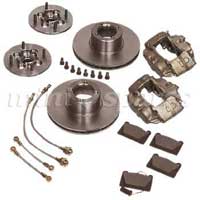
For use when converting cars which already have hubs fitted that hold calipers except 997/998 Cooper which will also require larger Constant velocity joints and Timken bearings, If you have brake shoe front drum brakes a kit C-AJJ4029A is available which contains all parts required..
The contents of this kit ... Read more
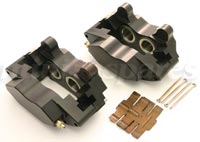
These calipers are intended for use on 12” wheels with 8.4”diameter solid discs.
When fitting vented discs, spacers are required to fit between the two halves (Spacer kit C-AJJ4021) If using vented discs the drive flange must also be changed to the relevant type NAM6450F. When fitting the calipers ensure the wheel studs are sitting flush in the flange or disc as they should be in standard form and not fouling in any way. Read more
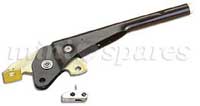
Unbolt handbrake from car and then remove rivet
(1) Once rivet has been removed, pull operating rod
(2) with pawl
(3) attached from handbrake, via plastic knob end. The original pawl will need replacing by removing the flat headed rivet
(4) The rod now requires bending true to plane, about 70mm from the hole end, down about 25mm.
(5)Although the new pawl is a different shape you are also moving fitting points from top hole to bottom hole, hence a bend of 20-25 degrees. Read more

Current performance levels achieved from the A series using modern cam designs combined with high ratio rockers have produce a demand for longer lasting valve train components.
The valve guide is no exception and to meet this demand more modern materiel specifications have been employed. Over the past five or six years many materials have been used to try and attain the desired criteria, many of which are so hard that the valve stems are wearing out instead. Read more
Material choices for guides are down to two distinct types - cast iron and bronze. Yes, cast iron. NOT steel as described in many adverts and by vendors.
Never have been, never will be. These are as fitted to the various A-series cylinder heads as standard in all applications. Cast iron is used because it is a very dissimilar metal from any used in valve manufacture - important to eliminate galling that causes seizure of the valves in the guides - is softer, yet resilient enough to wear well. Bronze, on the other hand, is a very general description as there are a variety of 'bronzes' used by various folk. In days gone by, the bronze base type used was 'PB1' (also known as 'Navy Bronze') - a phosphor-bronze alloy that was very orange in colour, and very soft, used primarily in race engines. Read more
For some reason, I have recently had a spate of queries about this stuff. So I thought I'd do a quick tech thing on it, seeing as most of the little available information is seemingly misleading.
'Into the valley of death, rode the six hundred.........' No, this isn't about silicone microchips, or anything about computers at all. Having just done that stuff on disc brakes, it prompted me into thinking about the braking systems as a whole, one thing lead to another, and, well, and brake fluid. More exactly, silicone based brake fluid. For some reason, I have recently had a spate of queries about this stuff. So I thought I'd do a quick tech thing on it, seeing as most of the little available information is seemingly misleading. Silicone based brake fluid has been heralded by some as being the last word in brake fluid, yet also brings a look of horror onto the faces of some. Strange, eh? Read more
You can only use the MS72 adjustable brake regulator/bias valve with a front/rear split system. Definitely NOT the diagonal split type (for identification see 'Brakes - Rear brake bias adjustment'). These should have been 'X-ed' at birth. Makes the car handle very interestingly when the system only operates the diagonally opposed brakes. Scary stuff. Almost as much fun as when the rears only work on a front/rear split set-up - particularly as the PDWA is built into the master cylinder, and it still has to go through the FAM7821 pressure regulator valve! Damn near no braking on the rear. Either way - split system brakes are grossly inefficient when only using half the system as they are designed to do when a failure in the other half occurs. Quite frightening. To install the MS72 into a front/rear split system, it needs fitting into the rear feed line. Determining which this is can prove difficult if the system has already been tampered with or new replacement components fitted. Namely the master cylinder. Read more
To use or not to use - that is the question! BRAKES - Silicone brake fluid, to use or not to use - that is the question! Over more recent years I've had affair number of discussions on the use of silicone brake fluid as opposed to the more common type. I have to say some folk are vehemence in their belief that this stuff is 'the answer' to all kinds of brake maladies. Some time ago I contacted the two major brake specialists in this country (UK) to see what they had to say. Their reactions was as vehemence as those believers above. For what it's worth, I thought I'd spread the word according to the manufacturers - which happens to be similar to my limited experience with this 'liquid savior'. Some has heralded silicone-based brake fluid as being the last word in brake fluid, yet also brings a look of horror onto the faces of some. The classic car folk swear by it, particularly for vehicles that are not used much where brake seal failure can be experienced, and because it does not affect paintwork. Read more
When altering the front brake set-up away from the standard installation, it invariably alters the amount of rear brake bias needed to re-balance the cars brake balance.
The problems start occurring when folk graft alternative brake set-ups onto the front of their Minis. Be this 7.5" discs onto a previously drum-braked model, or going from current standard disc set-ups to one of the 4-pot varieties. The question then is 'what bore size rear wheel-cylinders do I need?' Unfortunately this isn't straightforward. Actually, that's not strictly true - more on this later. The pressure developed in the lines determines brake effectiveness - aside from disc size, pad type, co-efficient of friction, etc. that is. Understanding this may assist in choosing which way you should go for your particular set-up.
The basic facts you need to remember when dealing with brake pressures is how they are affected by the components you use. Read more
One day I'm going to have to try and assess just how it is that every now and again I get a 'run' on folks asking me about a specific problem. These problems exist all year round, year in, year out. And said problems crop up throughout the year. But - every now and then there's a blood-rush on a certain issue. Just recently that issue has been brake pipe ends. The bit that seals the pipe off against it's relevant fitting. There are two types of end - male and female. The male end is convex in shape, the female concave. The male end is used where a male pipe union (nut) is used on the brake pipe - that's a nut with an external thread - that will be screwed into a female fitting such as found in a wheel cylinder or master cylinder. The female end is used where a female pipe union (nut) is used on the brake pipe - a nut with an internal thread - and will be mated to a male fitting such as found on rear flexible brake pipes. Under no circumstances should you mix the too up as the brake pipes simply will not be properly and safely sealed off. Read more
The past few years have witnessed a great deal of activity in the brake-swapping department by Mini enthusiasts world wide. The reasons are quite diverse, ranging from fashion to necessity. Some fit vented Metro 4 pot brakes because it’s the ‘in’ thing to do, giving max pose value. Some believe it’s a performance improvement, usually misguided by a misinformed vendor hell bent on making a sale. Some do it because they’ve been given a Metro, and their Mini’s endowed with drum-brakes. Some fit 7.5” S-type brakes because they want to fit 10” wheels on their late-type Mini. Some fit them because the racing discipline they compete in won’t allow anything else. Some even fit the disastrous 7” Cooper-type because it’s all they have. Whatever the reason or type of disc-brake set-up used, the effectiveness of the installation can be honed to perfection by the type of brake pads fitted. Indeed, using the correct brake pad on a current set-up could out perform any intended swap, such is their influence. Read more
When looking to increase their cars performance, most folks immediately turn to considering higher engine power outputs. Because of this pre-occupation brakes tend to slide down the improvements priority list. However, they are far more important - being able to accelerate at warp speed to hyper-space in the twinkling of an eye is all very well, but disastrous if you can’t stop. You will make a very big hole in the scenery, and possibly end up wearing an wooden over-coat. Getting the braking system sorted out can help to make the car quicker, as you will be able to more confidently, therefore maximising speed in any given situation. Being one of those ‘sciences’ used in the automotive industry I hope to shed some light on the subject as it's another of those where many questions from confused and mislead folks that clog up my e-mail board. The advent of the Metro, and the brakes used on it has spawned a lot of activity in this direction. It was soon discovered that they could be applied to a Mini pretty easily, and the later vented ones opened up a new area to exploit. Read more
What you actually need for the disc/drum conversion is pretty straightforward. Disconnect the steering arms, top and bottom swivel-pins, CV joint, and flexible brake pipes at the subframe - that’s it. There are, however, a number of ancillaries to consider.
Basics
Basics Fitting discs designed for the Mini is easy enough. Just make sure you use CV gaiters for the disc-brake set-up - these have a different bellows shape to stop the gaiter rubbing the inside of the hub. The drum type will rub, then split, shedding grease all over the place. Moly grease is mighty mucky stuff to deal with and doesn't assist braking at all! A tip for racers - to stop the gaiters over-expanding when getting very hot and imitating the aforementioned, put either a decent sized split pin or (my favorite) a piece of very small bore pipe - as in the type supplied with WD40 aerosols, etc. - under the retaining strap on the drive shaft. This allows air to escape and return, as the gaiter gets hot then cools..
Read more